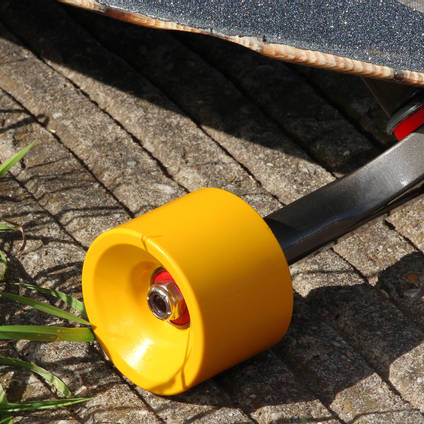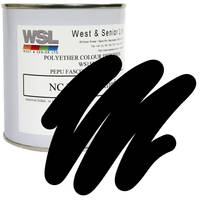Need any help or advice?+44 (0)1782 454499
Downloads (3)
| Safety Data Sheet (SDS) | ||
| Dutch Safety Datasheet | ||
| Technical Datasheet (TDS) |
Specification
Product Data
| Colour | Yellow | |
|---|---|---|
| Type | Opaque | |
| Format | Paste | |
| Brand | West & Senior |
Compatible With
| Compatible With | Polyurethane | Yes |
|---|
General Properties
| Gross Weight | 0.625 | kg |
|---|
Shipping Information
Restrictions
This product is not classed as dangerous goods for transport and can be shipped to all destinations without restriction.
Shipping to EU countries is now done through our European subsidiary based in the Netherlands. All EU customers should use www.easycomposites.eu.
Package Size
There are no package size restrictions or surcharges for this product.
Delivery Cost
To find the delivery cost of this item to your address, add it to your basket and then use the instant shipping calculator on the basket page.
Lemon Yellow Polyurethane Pigment
- PG-PU-YELLOW-LF-05
- No reviews
Manufactured by West & Senior and specially formulated for polyurethane resin, our lemon yellow pigment paste can be used to add intense solid yellow colour to any polyurethane resin. Triple milled for maximum colour intensity and easy dispersion into polyurethane resin.
Lighter colours like this yellow pigment are typically added at 5-10%. Available to buy online in 500g or 1kg packs.
PRODUCT VERSIONS
Pack Size
AVAILABILITY:More than 10 availablefor immediate shipping
Trade discounts
| 0-1 | 2+ |
|---|---|
| £12.95 | £10.25 |
We won’t be beaten on price!
If you believe you’re buying an equivalent product cheaper elsewhere, contact us to discuss your requirements.
Very high quality West & Senior LEMON YELLOW pigment for polyurethane resin.
Use this pigment to add vivid colour to any polyurethane casting resins including Fast Cast Casting Resin and our Waterclear Polyurethane Casting Resin.
All West & Senior pigment dispersions are made the very highest quality with pigments triple milled to reduce them to the finest particle size. Smaller particles means more vibrant colours from less pigment, improving the appearance of pigmented parts whilst minimising the performance reduction of the resin caused by pigmentation.
Typical Uses
Use to add solid colour to polyurethane casting or potting resins or any other polyurethane based resin system. A pigment ratio of 5-10% should be sufficient to add solid opaque colour in most applications.
Advantages
Pigment dispersions (pastes) should always be used when pigmenting polyurethane resin rather than pigment powder because the rigorous milling and mixing process during manufacture ensures that the tiny pigment particles are fully dispersed into a small amount of carrier polyurethane, getting the very most from their colour.
When a dispersion is then added to the bulk of the polyurethane resin it blends in easily, ensuring that the pigment is thoroughly mixed through the resin (rather than staying in lumps).
Because the dispersion is actually a mix of resin and pigment already, it is essential that the correct dispersion type is used to pigment each specific resin type. For example, polyurethane should only ever be pigmented using polyurethane (PU) dispersion pigment.
Trade discounts
| 0-1 | 2+ |
|---|---|
| £12.95 | £10.25 |
We won’t be beaten on price!
If you believe you’re buying an equivalent product cheaper elsewhere, contact us to discuss your requirements.
Very high quality West & Senior LEMON YELLOW pigment for polyurethane resin.
Use this pigment to add vivid colour to any polyurethane casting resins including Fast Cast Casting Resin and our Waterclear Polyurethane Casting Resin.
All West & Senior pigment dispersions are made the very highest quality with pigments triple milled to reduce them to the finest particle size. Smaller particles means more vibrant colours from less pigment, improving the appearance of pigmented parts whilst minimising the performance reduction of the resin caused by pigmentation.
Typical Uses
Use to add solid colour to polyurethane casting or potting resins or any other polyurethane based resin system. A pigment ratio of 5-10% should be sufficient to add solid opaque colour in most applications.
Advantages
Pigment dispersions (pastes) should always be used when pigmenting polyurethane resin rather than pigment powder because the rigorous milling and mixing process during manufacture ensures that the tiny pigment particles are fully dispersed into a small amount of carrier polyurethane, getting the very most from their colour.
When a dispersion is then added to the bulk of the polyurethane resin it blends in easily, ensuring that the pigment is thoroughly mixed through the resin (rather than staying in lumps).
Because the dispersion is actually a mix of resin and pigment already, it is essential that the correct dispersion type is used to pigment each specific resin type. For example, polyurethane should only ever be pigmented using polyurethane (PU) dispersion pigment.
Specification
Product Data
| Colour | Yellow | |
|---|---|---|
| Type | Opaque | |
| Format | Paste | |
| Brand | West & Senior |
Compatible With
| Compatible With | Polyurethane | Yes |
|---|
General Properties
| Gross Weight | 0.625 | kg |
|---|
The pigment is made up of mainly pigment powder with a small amount of the polyol Part A which means when adding the pigment, you should always add it to part A, to avoid any reaction occurring.
Due to the fact that only a very small amount of the weight of the pigment is resin (Part A), and pigment pastes are only added at low percentages themselves, it is generally not necessary to adjust the mix ratio of the resin when adding a pigment and so you should mix - for example: (100g resin part A + 5g pigment) with (100g resin part B).
The quantity of resin used in the pigment dispersions is very small and as such when the pigment is mixed into another resin, the additional amount of resin from the pigment is very small and in practical terms insignificant. As such you do not normally need to account for it within the mixing ratio calculations.
No, unfortunately you cannot use a pigment from one resin type with another resin type. You must use the correct pigment for the resin type you are using - eg a PU resin needs a PU pigment, a polyester resin needs a Polyester pigment and an epoxy resin needs an epoxy pigment.
This is because the pigment dispersions are a blend of pigment powders AND a small amount of base resin. Mixing the wrong pigment with a resin system may inhibit the resin cure and damage the end product
Yes, you can use the pigments in a resin infusion process, however if you are not using a gelcoat you will still get the colour from the fibre showing where it contacts the surface, with glass fabric the effect is diminished as the fibre is clear, but with densely coloured fibre like carbon it may affect the pigment.
If you need a very solid colour for epoxy infusion I would advise using Polyester Pigment in the GC50 Epoxy Compatible Gelcoat.
When using a pigment paste, it is best practice to mix the paste into the resin part of the mixture. We recommend doing this before adding the catalyst/hardener as it means you have as much time as you need to get a good even colour mixture without having to worry about reduced pot life.
The pigments used in this pigment dispersion will be excellent in terms of light fastness and weathering characteristics. If you are not already aware, pigments are graded for these properties on a blue wool scale, with 7-8 being the best. We tend to only source such grades for our dispersions with such high quality. However, the base resin system you are using these pigments with may be vulnerable to UV yellowing itself.
ASK YOUR OWN QUESTION
Customer Product Reviews for Lemon Yellow Polyurethane Pigment
SUBMIT YOUR OWN PRODUCT REVIEW
We publish all reviews for verified purchases. Submit your own review and help other customers with their choices.SUBMIT YOUR OWN PRODUCT REVIEW
We publish all reviews for verified purchases. Submit your own review and help other customers with their choices.Shipping Information
Restrictions
This product is not classed as dangerous goods for transport and can be shipped to all destinations without restriction.
Shipping to EU countries is now done through our European subsidiary based in the Netherlands. All EU customers should use www.easycomposites.eu.
Package Size
There are no package size restrictions or surcharges for this product.
Delivery Cost
To find the delivery cost of this item to your address, add it to your basket and then use the instant shipping calculator on the basket page.
RELATED PRODUCTS
CUSTOMERS ALSO PURCHASED
RELATED PRODUCTS
CUSTOMERS ALSO PURCHASED
100% SECURE
PAYMENT METHODS


Easy Composites Ltd, registered in England 7486797. All content copyright (C) Easy Composites Ltd, 2025. All rights reserved.

-Polyurethane-Pigment-500g.jpg)
-Polyurethane-Pigment-500g.jpg)
-Polyurethane-Pigment-500g.jpg)
